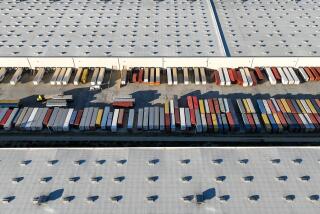Inland Empire sees surge in warehouse jobs, but many are low-pay, temporary
Pilar Guzman has worked for five years in a warehouse that processes luggage arriving from China and bound for the likes of Wal-Mart, Macy’s and Kohl’s.
She’s made minimum wage for the entire stint and arrives each day not knowing whether she’ll get called into work the next. One recent day, she taped 12,000 cardboard boxes.
“The work is very repetitive, and people tend to get hurt,” she said in Spanish through a translator.
Guzman is on the front lines of the fastest-growing industry in one of the fastest-growing job markets in California: the Inland Empire. Once the poster child for the woes of the housing crash, the eastern spoke of the Los Angeles metro area has rebounded swiftly over the last two years.
The fastest-growing sector has been the logistics industry — the truck drivers, inventory managers and warehouse workers serving an increasingly global and digital economy.
The sector created 1 in 5 jobs in the Inland Empire last year. That figure doesn’t include the huge proportion of warehouse workers supplied by temporary employment agencies, which typically offer less job security and fewer benefits.
Other workers, like Guzman, are employed by contractors who can’t always offer full-time positions because of fluctuating demand from big retailers.
As trade volume at the ports of Los Angeles and Long Beach has surged to near-record levels, Riverside and San Bernardino counties have become a strategic link in the global supply chain — an interior extension of the ports, a hub for goods traveling by truck and rail throughout California and the United States.
With ample, affordable land, the Inland Empire has in recent years given way to a real estate boom for mammoth warehouses, leased by giants such as Amazon.com, Home Depot and Nordstrom.
“For the industrial market, the Inland Empire is like office buildings in Manhattan,” said Joe Cesta, managing director of CBRE’s Ontario office. “It’s at the center of what happens.”
The rapid rise of e-commerce has put the Inland Empire at the leading edge of a retail revolution. The region’s warehouse workers have become the unseen store clerks of a one-click world.
A 2013 UC Riverside survey of warehouse workers found that about 60% of those employed at Southern California facilities worked for temp agencies, often with no health benefits and no guarantees of hours. The arrangement offers companies the flexibility to staff up or shed labor as demand fluctuates.
The temporary employment industry has grown jobs by 35% over the last five years in California, making it one of the state’s single fastest-growing industries. The logistics industry has been a major driver of that growth.
“We know this will bring jobs, but what kind of jobs?” said Jake Wilson, an associate professor of sociology at Cal State Long Beach and coauthor of “Getting the Goods,” which focuses on Southern California’s ports and logistics industry. “The vast majority of these workers are in very precarious working conditions.”
Staffing agencies operating in the Inland Empire include multinational, publicly traded companies such as TrueBlue Inc. as well as smaller companies serving mostly the local market.
Matt Thalmayer, president of Arrow Staffing in Redlands, said the majority of his business serves the warehousing sector. All employees who have a commitment of more than 30 hours a week qualify for health benefits, he said.
In the wake of the Great Recession, he said, many companies have relied on staffing agencies to manage regulatory changes in healthcare and workers’ compensation.
“As the government starts telling us how we need to operate, you’re going to see more and more survival techniques,” Thalmayer said. “And it may be through agencies like ours.”
Inland Empire politicians have invited the growth of the industry. They acknowledge that many logistics jobs are low-paying, but they believe the rapidly evolving industry will increasingly demand higher-level skills and pay higher salaries.
“It’s not just the forklift guys anymore,” said Fontana Mayor Acquanetta Warren. “Yes, there are the worker bees, but many jobs require analytics skills and the ability to use a computer.”
John Husing, chief economist for the Inland Empire Economic Partnership, said too many critics equate the entire industry with the lowest-level jobs. He notes that 80% of the jobs in the industry — including higher-paying management positions — require only a high school education or less.
“That’s who works in the industry — it’s people who’ve worked their way up,” Husing said. “There’s a whole evolution of people up the skill ladder.”
Much of the debate among economic experts centers on the wide range of jobs in the industry: from entry-level warehouse laborers who typically make less than $12 an hour to sales representatives making more than $35 an hour.
At Pacific Mountain Logistics in Ontario, Rodrigo Espitia started out as a forklift driver about two years ago. Since then he’s worked himself into a lead role at the warehouse, supervising the packaging of all outgoing goods delivered to customers.
He’s gotten a raise from $12 to $14 an hour. He sees a lot of opportunities for those who work with speed and precision.
“I’m here because I don’t make lots of mistakes,” Espitia said as he double-checked the billing and shipping details for outgoing electronics. “You always have to be on top of everything, and make the customer happy.”
Inside the 160,000-square-foot warehouse, a half-dozen forklift drivers constantly honked their horns, warning as they turned corners and backed up with loads of patio furniture just off ships from China. The company has tripled its workforce in the last three years, said owner B.J. Patterson.
As the economy has emerged from the recession, he said, there has been a much greater emphasis on speed, as manufacturers and retailers have worked to cut costs by reducing inventory. He said it has changed the conventional notion of a warehouse as a place where goods are stockpiled.
“The majority of what we get in has to be out and headed to the customer within a week or less,” Patterson said. “It’s less storage and more movement.”
A few miles east in Mira Loma, Guzman said she and most of her fellow workers have little hope of getting a raise or steady hours. She often has pain in her lower back after standing all day, but she said managers often don’t allow workers to rotate through different tasks to ease the stress.
The warehouse where she works, owned by Olivet International, was cited in 2013 by California’s Occupational Safety and Health division for several safety violations, including failure to provide sufficient light for workers unloading at night and insufficient safety protocols for forklift drivers.
The company agreed to a settlement with the National Labor Relations Board last year involving alleged retaliation against employees who stopped working because of excessive heat.
Peter Lin, secretary for Olivet’s board of directors, said he could not comment on Guzman’s specific issues because they are private personnel matters. He said that the issues involving state and federal agencies are in the past and that the company has installed state-of-the-art fans in the warehouse to address the heat issues.
“Our equipment and our practices are easily on par, and I’d like to think are exceeding, industry averages,” Lin said. “We do take employees’ concerns very seriously, and employees are welcome to come up to our management and our HR department to talk and express their concerns.”
Experts say logistics will undoubtedly play a major role in the region’s future. But they say local politicians and economic development officials should carefully consider whether it will make the Inland Empire workforce more prosperous.
“The mantra has been ‘Let’s encourage this industry,’ but without regard to what’s happening to a large segment of the workforce,” said Juan DeLara, an assistant professor of American Studies at USC who follows the Inland Empire economy. “The question is not, ‘How do you stop it?’ It’s about how you at least have an honest conversation about it.”
Times staff writer Tiffany Hsu contributed to this report.
More to Read
Inside the business of entertainment
The Wide Shot brings you news, analysis and insights on everything from streaming wars to production — and what it all means for the future.
You may occasionally receive promotional content from the Los Angeles Times.











